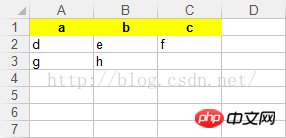Home > Article > Backend Development > Reading and writing Excel documents with Python
本篇文章给大家分享的是用Python读写Excel文档 ,有需要的朋友可以参考一下文中的内容
1.读取Excel(需要安装xlrd):
import xlrd
fname = "reflect.xls"
bk = xlrd.open_workbook(fname)
shxrange = range(bk.nsheets)
try:
sh = bk.sheet_by_name("Sheet1")
except:
print "no sheet in %s named Sheet1" % fname
#获取行数
nrows = sh.nrows
#获取列数
ncols = sh.ncols
print "nrows %d, ncols %d" % (nrows,ncols)
#获取第一行第一列数据
cell_value = sh.cell_value(1,1)
#print cell_value
row_list = []
#获取各行数据
for i in range(1,nrows):
row_data = sh.row_values(i)
row_list.append(row_data)2.写入Excel(需安装pyExcelerator)
from pyExcelerator import *
w = Workbook() #创建一个工作簿
ws = w.add_sheet('Hey, Hades') #创建一个工作表
ws.write(0,0,'bit') #在1行1列写入bit
ws.write(0,1,'huang') #在1行2列写入huang
ws.write(1,0,'xuan') #在2行1列写入xuan
w.save('mini.xls') #保存3.再举个自己写的读写Excel的例子
读取reflect.xls中的某些信息进行处理后写入mini.xls文件中。
import xlrd
from pyExcelerator import *
w = Workbook()
ws = w.add_sheet('Sheet1')
fname = "reflect.xls"
bk = xlrd.open_workbook(fname)
shxrange = range(bk.nsheets)
try:
sh = bk.sheet_by_name("Sheet1")
except:
print "no sheet in %s named Sheet1" % fname
nrows = sh.nrows
ncols = sh.ncols
print "nrows %d, ncols %d" % (nrows,ncols)
cell_value = sh.cell_value(1,1)
#print cell_value
row_list = []
mydata = []
for i in range(1,nrows):
row_data = sh.row_values(i)
pkgdatas = row_data[3].split(',')
#pkgdatas.split(',')
#获取每个包的前两个字段
for pkgdata in pkgdatas:
pkgdata = '.'.join((pkgdata.split('.'))[:2])
mydata.append(pkgdata)
#将列表排序
mydata = list(set(mydata))
print mydata
#将列表转化为字符串
mydata = ','.join(mydata)
#写入数据到每行的第一列
ws.write(i,0,mydata)
mydata = []
row_list.append(row_data[3])
#print row_list
w.save('mini.xls')4.需要根据Excel文件中满足特定要求的apk的md5值来从服务器获取相应的apk样本,这样做:
import xlrd
import os
import shutil
fname = "./excelname.xls"
bk = xlrd.open_workbook(fname)
shxrange = range(bk.nsheets)
try:
#打开Sheet1工作表
sh = bk.sheet_by_name("Sheet1")
except:
print "no sheet in %s named Sheet1" % fname
#获取行数
nrows = sh.nrows
#获取列数
ncols = sh.ncols
#print "nrows %d, ncols %d" % (nrows,ncols)
#获取第一行第一列数据
cell_value = sh.cell_value(1,1)
#print cell_value
row_list = []
#range(起始行,结束行)
for i in range(1,nrows):
row_data = sh.row_values(i)
if row_data[6] == "HXB":
filename = row_data[3]+".apk"
#print "%s %s %s" %(i,row_data[3],filename)
filepath = r"./1/"+filename
print "%s %s %s" %(i,row_data[3],filepath)
if os.path.exists(filepath):
shutil.copy(filepath, r"./myapk/")使用xlwt3进行Excel文件的写操作:
import xlwt3
if __name__ == '__main__':
datas = [['a', 'b', 'c'], ['d', 'e', 'f'], ['g', 'h']]#二维数组
file_path = 'D:\\test.xlsx'
wb = xlwt3.Workbook()
sheet = wb.add_sheet('test')#sheet的名称为test
#单元格的格式
style = 'pattern: pattern solid, fore_colour yellow; '#背景颜色为黄色
style += 'font: bold on; '#粗体字
style += 'align: horz centre, vert center; '#居中
header_style = xlwt3.easyxf(style)
row_count = len(datas)
col_count = len(datas[0])
for row in range(0, row_count):
col_count = len(datas[row])
for col in range(0, col_count):
if row == 0:#设置表头单元格的格式
sheet.write(row, col, datas[row][col], header_style)
else:
sheet.write(row, col, datas[row][col])
wb.save(file_path)输出的文件内容如下图:

挺容易的吧!那么,快来试试!
相关推荐:
Python读写sqlite3数据库的方法并且将数据写入Excel的实例详解
The above is the detailed content of Reading and writing Excel documents with Python. For more information, please follow other related articles on the PHP Chinese website!